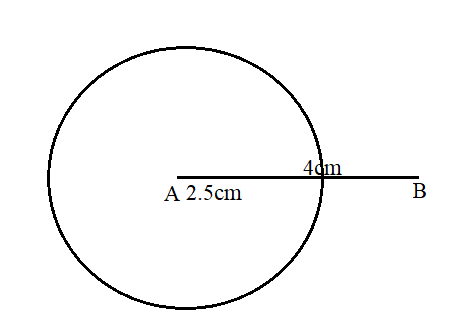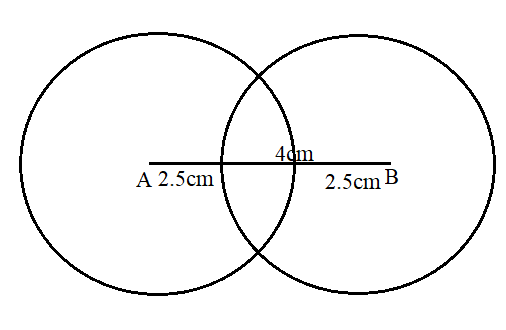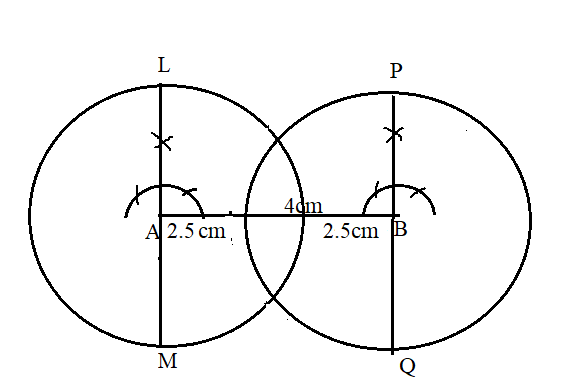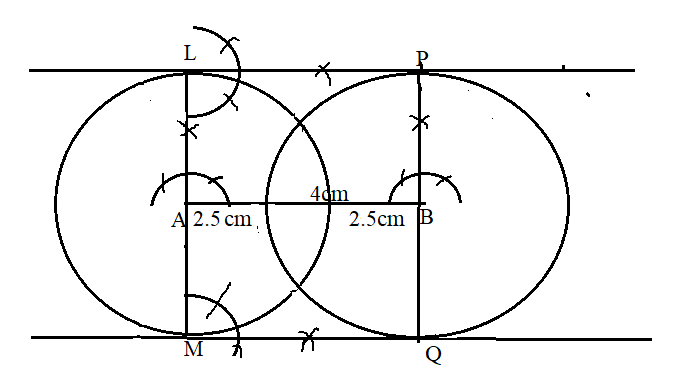
Draw a pair of direct common tangents to two circles of radii 2.5cm whose centers are at 4cm apart.
Answer
576.3k+ views
Hint: First draw a line segment of 4cm and then draw the circles of radius 2.5 cm on both the ends of the line segment. Then, construct perpendicular on the endpoints of the line segment. Draw perpendiculars on both ends of the line which is perpendicular and passing through the radius.
Complete step by step Answer:
We begin the construction by drawing a line segment of line 4cm.

We want to construct circles whose center is 4cm apart. Since AB is a line of 4cm.
Both circles have a radius of 2.5cm.
Then, taking A as center construct a circle of radius 2.5 cm.

Similarly, construct a circle of radius 2.5cm by taking B as the center.

Now, we want to construct a pair of common tangents to both circles.
We know that the tangent to any circle is perpendicular to the radius of the circle.
And we want the common tangents then the radius to which the tangents are drawn should be parallel.
Hence, draw a perpendicular LM at A and PQ at B, then, LM will be parallel to PQ

We will now draw tangents passing trough points L and P, and one tangent passing through M and Q.
Draw a perpendicular to LM at point L and perpendicular to PQ at line Q.
And join the lines LP and MQ which are a pair of tangents to the two circles.

Note: A tangent is a line that touches the circle at one point. The tangent is perpendicular to the radius. While doing construction, make sure the pencil is sharp and the compass is kept properly to avoid errors.
Complete step by step Answer:
We begin the construction by drawing a line segment of line 4cm.

We want to construct circles whose center is 4cm apart. Since AB is a line of 4cm.
Both circles have a radius of 2.5cm.
Then, taking A as center construct a circle of radius 2.5 cm.

Similarly, construct a circle of radius 2.5cm by taking B as the center.

Now, we want to construct a pair of common tangents to both circles.
We know that the tangent to any circle is perpendicular to the radius of the circle.
And we want the common tangents then the radius to which the tangents are drawn should be parallel.
Hence, draw a perpendicular LM at A and PQ at B, then, LM will be parallel to PQ

We will now draw tangents passing trough points L and P, and one tangent passing through M and Q.
Draw a perpendicular to LM at point L and perpendicular to PQ at line Q.
And join the lines LP and MQ which are a pair of tangents to the two circles.

Note: A tangent is a line that touches the circle at one point. The tangent is perpendicular to the radius. While doing construction, make sure the pencil is sharp and the compass is kept properly to avoid errors.
Recently Updated Pages
Why are manures considered better than fertilizers class 11 biology CBSE

Find the coordinates of the midpoint of the line segment class 11 maths CBSE

Distinguish between static friction limiting friction class 11 physics CBSE

The Chairman of the constituent Assembly was A Jawaharlal class 11 social science CBSE

The first National Commission on Labour NCL submitted class 11 social science CBSE

Number of all subshell of n + l 7 is A 4 B 5 C 6 D class 11 chemistry CBSE

Trending doubts
What is meant by exothermic and endothermic reactions class 11 chemistry CBSE

10 examples of friction in our daily life

One Metric ton is equal to kg A 10000 B 1000 C 100 class 11 physics CBSE

1 Quintal is equal to a 110 kg b 10 kg c 100kg d 1000 class 11 physics CBSE

Difference Between Prokaryotic Cells and Eukaryotic Cells

What are Quantum numbers Explain the quantum number class 11 chemistry CBSE




